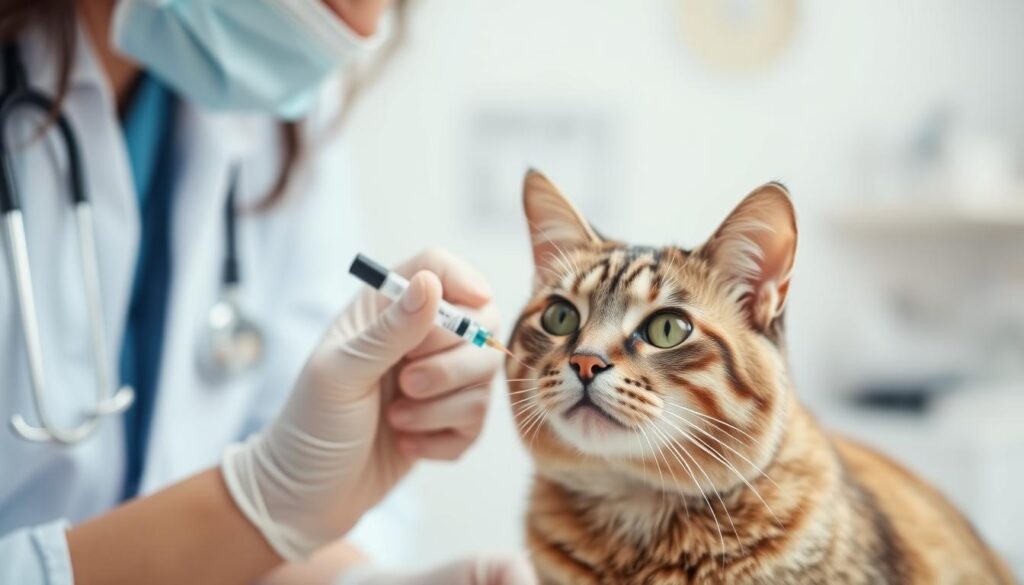Ever wondered about the early signs of rabies in cats? As a pet owner, knowing these signs is key. Rabies is a deadly virus that can harm our cats. Spotting the warning signs early can save your cat and your family.
What are the signs that your cat might have rabies? This guide will help you keep your pet safe.
Table of Contents
Understanding Feline Rabies: Essential Information
Rabies is a deadly virus that can harm our cats. As cat owners, knowing about rabies is key. It helps us protect our feline rabies from this serious illness.
What Causes Rabies in Cats
Rabies comes from a virus in the Rhabdoviridae family. It spreads through infected animals’ saliva, often from bites. After entering the body, the virus moves to the brain and spinal cord, reaching the salivary glands.
How Rabies Spreads Between Animals
Rabies in kittens and adult cats usually comes from infected animals’ saliva. In the U.S., raccoons, bats, foxes, and skunks are main carriers. They pose a big risk to both domestic and feral cats.
Geographic Distribution of Rabies
Rabies is found worldwide, except in Australia and Antarctica. In North America, wildlife like skunks and raccoons are key sources. In Europe, foxes are the main carriers. In Asia, Africa, and Latin America, stray dogs are the biggest risk.
| Region | Primary Rabies Reservoirs |
|---|---|
| North America | Skunks, raccoons, foxes, bats |
| Europe | Foxes |
| Asia, Africa, Latin America | Stray dogs |
“Rabies is almost always fatal for unvaccinated animals, with death usually occurring within 7 to 10 days after symptoms begin.”
Rabies Symptoms in Cats: From Early Signs to Advanced Stages
Rabies is a deadly virus that can harm our cats badly. Knowing the signs of rabies in cats is key to catching it early. This helps us get our cats to the vet fast.
In the early days, rabies symptoms in cats might be small. Cats might act differently, like being more agitated or shy. As rabies gets worse, cats can get aggressive, have muscle spasms, drool a lot, and have trouble eating. Their eyes will also get bigger.
As rabies gets even worse, things get really bad. Cats can’t move, fall into a coma, and sadly, die. This usually happens in 7-10 days. This shows how fast we need to act.
“Rabies has been recognized and described since approximately 2300 BC, and it remains a significant global health concern, affecting most countries worldwide.”
Seeing feline rabies symptoms early and getting vet help fast is very important. By acting quickly, we can save our cats’ lives. This stops the bad effects of this deadly virus.
The Three Phases of Rabies Infection
Rabies is a deadly virus that cats can get. It goes through three main stages. Knowing these stages helps spot the signs early and get help fast. Let’s look at the three stages of rabies in cats:
Prodromal Stage
The first stage, the prodromal stage, lasts about 2-3 days. Cats may act differently, like being more restless or anxious. They might also eat less or show less love.
Furious Stage
The furious stage is the most dangerous. Cats get very aggressive and drool a lot. Rabies virus symptoms cats are most contagious during this time, spreading through bites or scratches.
Paralytic Stage
The final stage is the paralytic stage. It leads to coma and death in about 7 days. Cats may have muscle weakness, trouble swallowing, and breathing problems.
Not all cats show all three stages of rabies. Some may die without showing all symptoms.
“Over 30,000 people worldwide still die of rabies every year, and reported cases of rabies in domestic cats have outnumbered those in dogs every year since 1990.”
High-Risk Scenarios and Transmission Methods
Rabies is a big worry for cat owners. Cats that go outside, especially where animals like raccoons and bats live, are at higher risk. Cats without shots or whose shots are out of date are even more at risk.
Mostly, rabies spreads through bites, but scratches can also pass it on. In the U.S., more cats than dogs get rabies. This makes getting shots for indoor and outdoor cats very important. Rabies in kittens and cat rabies vaccination are key for pet owners.
“On average, the incubation period for rabies in cats is two months but can vary.”
Every year, over 55,000 people worldwide die from rabies. Most of these deaths happen in Asia and Africa. In the U.S., while rabies is rare, about 60,000 people get shots after being bitten.
- In the U.S. in 2008, 93% of rabies cases were in wildlife, with cats accounting for 4.3% of the cases.
- There was a 12% increase in rabid cats in 2008 compared to 2007.
- Cats in certain European countries are considered high-risk species for rabies transmission to humans.
Keeping your cat’s shots up to date and keeping them inside in areas where rabies is common is key. Knowing the risks and how rabies spreads helps protect your cat and your community.

Diagnosing Rabies in Felines: What Pet Owners Should Know
Figuring out if your cat has rabies is very important but tricky. Sadly, there’s no test for rabies in cats that works while they’re alive. The only way to really know is by looking at the brain after the cat has passed away.
Why Living Tests Aren’t Possible
Rabies is a fast-moving, deadly disease that affects the brain. Once a cat shows signs of rabies, it usually doesn’t live long. It’s not right to do tests on a living cat because of how deadly the virus is.
Post-Mortem Diagnosis Process
- If rabies is thought to be present, the cat must be put down and its brain taken out carefully.
- Then, special labs do two tests on the brain: immunofluorescence microscopy and PCR.
- These tests can find the rabies virus, giving a clear diagnosis.
- Because rabies is a big health risk, any suspected cases must be told to animal health officials right away.
Understanding how to diagnose rabies in cats is key for pet owners. The best way to protect your cat is to keep their rabies shots current. This is the main way to fight against this terrible disease.
“Rabies in domestic animals, including cats, is uncommon in the United States. In 2018, there were only 241 cases of rabies in cats reported to the CDC.”
Prevention Through Vaccination: Your Cat’s Best Defense
Vaccination is the best way to protect your cat from rabies. In most places, it’s the law for cats to get vaccinated. This helps keep your pet and others safe.
Kittens get their first rabies shot between 12 and 16 weeks old. They need a booster shot a year later. After that, they need shots every 1 to 3 years, depending on where you live and the vaccine type. These shots are safe and work well, with only a small chance of side effects.
Keeping your cat inside also helps prevent rabies. Make sure their shots are current. This way, you give them the best chance to stay safe from rabies.
| Vaccine Effectiveness | Immunity Duration |
|---|---|
| Some feline vaccines, like those against rabies, typically offer a high protection rate but do not provide 100% protection to every recipient. | Immunity from early vaccination can potentially last a cat most or all of its lifetime, especially against the Distemper virus. |
| Feline vaccines like the Feline Leukemia vaccine may only offer about 60% protection against a strong disease challenge. | A common misconception is that all feline vaccines guarantee complete protection, which is not the case. |
| Certain feline vaccine products may offer little to no individual protection but could assist in reducing disease prevalence in a population, such as in a cattery. | Proper understanding of the difference between vaccination and immunity is crucial for cat owners to make informed decisions about feline vaccinations. |
By knowing the facts and getting your cat vaccinated, you can keep them safe from rabies. Talk to your vet to create a vaccination plan for your cat. This will help keep them healthy and safe.

Post-Exposure Protocol and Management
If your cat has been exposed to a potentially rabid animal, get them to a vet right away. Vaccinated cats might get a booster shot and then be watched for a while. But, unvaccinated cats could face long quarantine or even euthanasia, based on local rules and risk.
Immediate Actions After Exposure
First, wash the wound with soap and water if you think your cat was exposed to rabies. This can lower the chance of the virus getting in. Then, take your cat to a vet right away.
Quarantine Requirements
- Vaccinated cats might get a booster shot and be watched for 45 days.
- Unvaccinated cats could need to be quarantined for 4 months or even be put down, depending on local laws and risk.
Treatment Options
There’s no cure for rabies once symptoms show. The virus is deadly for both humans and animals. So, we focus on preventing it with vaccines and post-exposure care.
| Key Statistic | Value |
|---|---|
| Most dogs, cats, and ferrets should not be vaccinated before 3 months (12 weeks) of age. | 12 weeks |
| An animal is considered immunized 28 days after initial vaccination. | 28 days |
| Animals with any vaccination history are considered vaccinated immediately after a booster. | Immediately |
Managing rabies exposure is key to keep your cat and family safe. Knowing what to do first, quarantine rules, and treatment limits helps protect your pet. This way, you can keep your cat healthy and reduce the risk of rabies treatment cats or feline rabies symptoms.
Human Risk Factors and Safety Measures
Rabies in cats is a big risk to human health. It can spread through bites or when infected saliva touches mucous membranes or open wounds. If you own a cat, it’s important to avoid touching sick animals. Also, get medical help right away if you’re bitten or scratched by a cat that might have rabies.
To lower the risk of getting rabies, make sure your cat’s vaccinations are current. Also, keep your cat indoors. It’s smart to stay away from wild animals like bats, raccoons, and skunks. They can carry the rabies virus. Tell health officials if you think a cat might have rabies to protect others.
Protecting yourself and your pets from rabies is key. Early signs of rabies and quick medical care are crucial. They help manage the disease and prevent serious harm.


1 thought on “Rabies Symptoms in Cats: Warning Signs to Know”